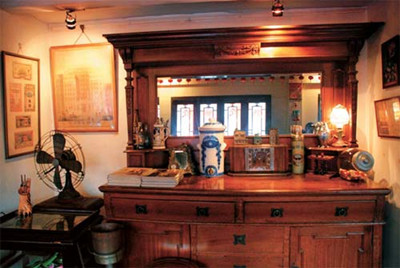歷史房屋博物館
Keeping up appearances
永葆“青春”
When federal money runs out, ingenuity is called for
聯邦資助山窮水盡,匠心獨具柳暗花明
“THE past is never dead. It's not even past,” wrote William Faulkner in “Requiem for a Nun”. In his house, Rowan Oak, you can almost touch the typewriter on which he tapped out those words. It sits on a desk in his study, protected merely by a rope across the door.
威廉福克納在《修女的安魂曲》一書中寫到“逝者不歿,實未曾逝也。”在其故居“花楸橡樹”,你甚至可以親手撫摸當年他打出這些文字的打字機,它佇在書房的寫字臺上。

Rowan Oak stands in a glade near the centre of Oxford, Mississippi. Faded signs and keen volunteers direct visitors round the property in which the writer lived for 32 years. Wonky floors, spartan bedrooms and the author's pipe, boots and spectacles await them. Those who forget the cash for the $5 entry fee can squeeze inside anyway with the promise of a cheque to follow. After all, as Faulkner noted, “Money has no value. It is just how you spend it.”
“花楸橡樹”位于距離密西西比的牛津市中心不遠的一塊沼澤上,此處,根據褪色的標牌和熱心的志愿者的指引,你可以游覽這所作家曾生活過32年的居所。這里地板嘎吱作響,床鋪簡單樸素,作家的煙斗,長靴和眼鏡安之若素,那些忘記付5塊門票的人,保證之后補上一張支票,也可擠入人群探個究竟,“金本無利,使之得力,方才有益”福克納所言極是。
But Rowan Oak needs more spending. Though it was restored in 2005 at a cost of $1.5m, more than a third of which was covered by the University of Mississippi, which owns the site, the house now “needs a paint job really badly”, according to its curator, William Griffith. In addition to maintenance, however, the fees collected from around 30,000 visitors a year have to pay the electricity and phone bills. “It's a tough business,” he admits.
但門票費遠不能維系“花楸橡樹”的維護開支,雖然2005維修的150萬美元費用有三分之一都由密西西比大學負擔,畢竟地產在該大學名下,但據管理者所言威廉所言,“它現在亟需油漆粉刷”。除維護外,每年從三萬游客身上收取的一部分費用還要用于支付電費和電話費,威廉也承認“這筆收入著實難以為繼”。
Securing sufficient funds to keep historic sites up to scratch is tricky across the South. Almost a third of Rowan Oak's renovations were paid for by Save America's Treasures, a competitive grants programme started in the Clinton years. Congress's decision in 2011 to stop funding the programme has hurt house museums most, according to Stephanie Meeks, head of the National Trust for Historic Preservation, a private charity. “It was the only bricks-and-mortar funding scheme run by the federal government,” she says.
縱觀整個南部地區,想要確保歷史遺跡的修繕費用充足都不容易,雖然之前'花楸橡樹‘三分之一的修繕費用都來自保護美國遺產組織,它實力雄厚,但2011年國會已決定停止資助這個始于克林頓時代的贈款項目,據私有慈善組織國家歷史建筑保護信托負責人所言,房屋博物館深受其害,畢竟那是唯一一個受聯邦政府資助的實體項目。”
And keeping crumbling old buildings together is expensive. Around $12m in the past four years has gone on maintaining 26 historic sites across America run by the National Trust for Historic Preservation. “It's tremendous work to keep these places looking nice,” says Toby Aldridge, the resident guide at the childhood house museum of another great southern writer, Flannery O'Connor. But renovations in 2007 have improved visitor numbers since, he says, and a student helped with the paint analysis for the green-and-gold living room. So far this year more than 2,600 people have come, already more than in 2013. The author's childhood books, such as “Five Little Peppers and How they Grew”, are on display—a far cry from the raw rural tales O'Connor would write herself.
但維修這些搖搖欲墜的房屋開支不菲,國家歷史建筑保護信托負責的26處遺跡維修在過去四年里花了將近1200萬美元,另一個南部作家弗蘭納里奧康納的童年故居負責人托比說,讓這些地方看上去光鮮亮麗真不是一項小工程,但2007年的修繕工作之后,游客數量確實增加了,同時一個學生也在幫忙規劃金綠色客廳的粉刷工作。今年的游客數量已達到2600人,比2013年多,一些作家童年讀的書如“Five Little Peppers and How they Grew”也在這里展出,他們與奧康納寫的鄉村故事迥然不同。
Andalusia Farm, near Milledgeville, was O'Connor's home when she wrote most of her stories. The museum that is now there once got money from Save America's Treasures, but now uses timber from its 544-acre (220-hectare) estate for repairs to keep costs down. It also depends on donations from individuals to cover its $220,000 operating budget each year. The farm's director, Elizabeth Wylie, has expanded an annual bluegrass festival at the site, started a supper club and opened a reading room to try to attract more locals. “Innovation is the watchword,” she says.
米利齊威爾附近的Andalusia農莊便是奧康納的家,她在這里完成了大部分著作,這一所博物館過去也受到保護美國遺產協會的資助,但現在只能指望來自它554英畝房產里的木材進行修繕,同時它也接收私人捐款,來負擔每年22萬的預算,農場主伊麗莎白在原址上擴大了藍綠莖牧草節的規模,建立了晚宴團體,開設讀書室,吸引當地人,她說“創新才是硬道理.
Ms Meeks agrees. The greatest threat to house museums is other house museums, she says—especially as America has around 15,000 of them. Her organisation is exploring partnerships with restaurants and shops at certain sites as a way to find extra income and draw more visitors. But private philanthropists help most. A recent $10m gift for Montpelier, the estate where President James Madison lived in Virginia, will pay for, among other things, rebuilding the site's slave quarters. Other houses are less fortunate in their friends. At Rowan Oak, “We barely make it, but we do make it—just like Faulkner,” Mr Griffith says.
米克對此也同意,她說,房屋博物館同業之間的競爭最為劇烈,他的組織正嘗試與一些餐廳店鋪形成合作伙伴關系,以贏得更豐厚的收入,吸引更多旅客,但是私有的慈善機構還是最有力的合作伙伴,詹姆斯麥迪森在弗吉尼亞的住所最近也迎來了一筆1000萬美元的援助,主要將用于重建,但相比之下,其他的一些居所便沒那么幸運。至于花楸橡樹,威廉說,我們艱難困苦,但將竭盡全力。譯者:張孟夏












